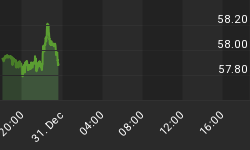Below is an excerpt from a commentary originally posted at www.speculative-investor.com on 29th August, 2010.
Displayed below is a long-term weekly chart of the Barrons Gold Mining Index (BGMI) with a log scale. The chart includes the BGMI's 200-week moving average (in red) and two upward-sloping trend-lines (in green). We've given the trend-lines the same slope to show that the gold sector's current long-term bull market is progressing at roughly the same pace as the long-term bull market that ran from the early 1960s through to 1980. Also, we've labeled points on the two major up-trend lines to illustrate our view that the October-2008 low can be considered to be the equivalent of the January-1970 low.

There are clearly similarities between the first half of the 1960s-1970s bull market and what's happened over the past 10 years, so the BGMI's performance during the 1970s could be a useful model over the years ahead. However, we do not think that today's financial/economic backdrop has much in common with that of the 1970s. Of particular importance, the decade of the 1970s occurred in the midst of a secular expansion of private-sector credit, but it's very likely that we are now two years into a secular contraction of private-sector credit. The contraction of private-sector credit and the downward pressure that this puts on the supply of money could have created a very bearish backdrop for gold, but governments have chosen to offset this deflationary force by aggressively ramping up their own spending/borrowing, with central-bank monetary support. Consequently, there is the possibility (we would say likelihood) of what would otherwise have been a deflationary cleansing process being transformed into an inflationary depression.
Getting back to the BGMI chart, at the beginning of the 1970s there was a very sharp pullback to the long-term trend-line (labeled "2" on the chart). At this stage we are not expecting a repeat of this sharp pullback. There remains a risk that the gold-stock indices will decline to near their February lows within the next two months, but note that a decline of this magnitude would barely register on the above long-term chart.
The above weekly BGMI chart covers the past 40 years, while the following weekly HUI chart zooms in on the past 12. The blue line on the chart is the HUI's 200-week moving average.
The HUI chart reveals that the massive losses of 2008 were fully recouped by December of 2009, and that the HUI has spent all of this year 'chopping' back and forth below its March-2008 and December-2009 peaks. The chart pattern allows for two very different interpretations, one being that a major "double top" was put in place during 2008-2009 and the other being that everything since last December's peak has been a fairly routine intermediate-term correction within the long-term bull market's second major upward leg. We continue to believe that the latter interpretation is correct, because we see no evidence that gold's secular bull market is over and a lot of evidence indicating that it has a long way to go. Our view is that some time within the next 6 months -- it could be this September, or early next year, or some time in between -- the HUI will break decisively above 500, confirming that it has commenced the second intermediate-term advance of its second major upward leg of its long-term bull market.

We aren't offering a free trial subscription at this time, but free samples of our work (excerpts from our regular commentaries) can be viewed at:http://www.speculative-investor.com/new/freesamples.html
















